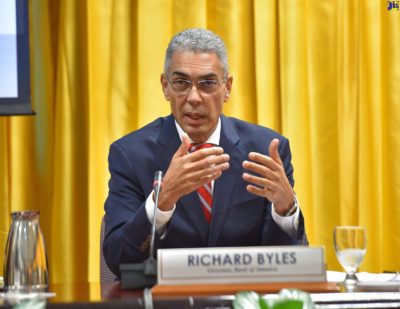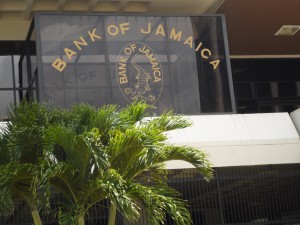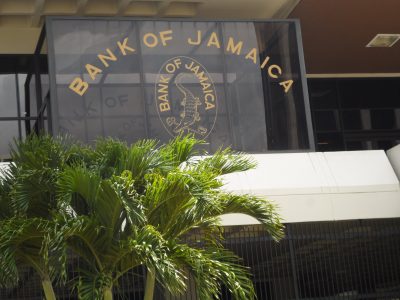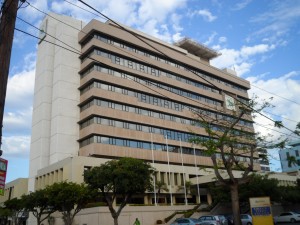In the 1990s, the then government of Jamaica appointed a failed central banker in an African country as governor of Bank of Jamaica in combination with a failed Minster of Finance they collectively destroyed the Jamaican economy and the financial sector by maintaining stiflingly high interest rates that have set back this country for decades.
 Now that the country is recovering from those calamitous years, the country employed what is in effect a retired non practicing economist as head of the central bank. No major country in the world has placed such a person as head of their central bank.
Now that the country is recovering from those calamitous years, the country employed what is in effect a retired non practicing economist as head of the central bank. No major country in the world has placed such a person as head of their central bank.
In a letter to the Minister of Finance around April last year Byles advised the MOF why rates had to be kept at levels well below inflation. According, to the central bank that was to facilitate growth and any increase, would trim the growth level quite a bit.
In reality, GOJ was the major beneficiary of the low interest rates and lenders to banks were subsidizing the goverment by getting little interest on their money.
This publication had repeated disagreed with the BOJ policy of abnormally low interest rates as having disastrous consequences for the economy. The chickens are now rooting and the central bank is panicking with the latest measured knee-jerk 1.5 percent in its overnight rate to 4 percent.
Up to June last year Bank of Jamaica (BOJ) held the policy interest rate unchanged at 0.50 percent per annum. According to the Central Bank, the decisions taken then by Bank of Jamaica are aimed at ensuring that the annual increase in the prices of consumer goods and services remains within the Bank’s inflation target of 4 to 6 percent.
The decision to hold the policy rate unchanged was made by a unanimous vote by the Bank’s Monetary Policy Committee (The Committee/MPC). This decision was based on the MPC’s assessment that, despite recent increases in international commodity prices, the existing stance of monetary policy remains appropriate to support inflation within the target range over the next two years. The Bank’s accommodative monetary policy posture is also aimed at supporting a recovery in economic activity in Jamaica.
Something seems to have blinded the eyes of the MPC who met again in August but only move rates by a huge 100 basis point then and now 1.5 percent. All talk of growth has completely gone from the justification for keeping rates well below inflation.
The message seems clear, the central bankers and the MPC are clueless as to what they are dealing with.
Time for Byles to go
BOJ overnight rate still 0.50%
Bank of Jamaica announced the decision to maintain its accommodative monetary policy stance by holding the overnight policy rate offered to deposit-taking institutions at 0.50 percent per annum.
 In announcing the decision to hold the rate Governor of the Bank of Jamaica, Richard Byles, stated, “I think it is important to emphasize that Jamaica’s financial system remains sound, well-capitalized and its current holdings of Jamaica Dollar liquid balances remain adequate. To ensure that orderly conditions are maintained, Bank of Jamaica has taken some pre-emptive measures to assure financial institutions and the public of adequate access to both Jamaica Dollar and foreign currency liquidity during this challenging period. There are a total of eight such measures, three in respect of foreign currency and five to do with Jamaica dollar liquidity.”
In announcing the decision to hold the rate Governor of the Bank of Jamaica, Richard Byles, stated, “I think it is important to emphasize that Jamaica’s financial system remains sound, well-capitalized and its current holdings of Jamaica Dollar liquid balances remain adequate. To ensure that orderly conditions are maintained, Bank of Jamaica has taken some pre-emptive measures to assure financial institutions and the public of adequate access to both Jamaica Dollar and foreign currency liquidity during this challenging period. There are a total of eight such measures, three in respect of foreign currency and five to do with Jamaica dollar liquidity.”
The central bank introduced a number of measures including the continued support of the foreign exchange needs of businesses in the real sector through direct sales to authorized dealers and Cambios, as needed. Increased limit on the foreign currency net open positions of authorized dealers by 5 percentage points.
The central bank states that it stands ready to expand the volume of foreign currency swap arrangements with authorized dealers. The stock of outstanding swap contracts now totals US$86 million.
The Bank commenced a bond-buying programme of GOJ securities on the secondary market from financial institutions and is prepared to effect early redemption BOJ securities. The Bank has so far purchased $26.3 billion GOJ instruments.
BOJ removed the limit on the amounts that deposit-taking institutions (DTIs) can borrow overnight without being charged a penal rate.

BOJ interest cuts overnight rate.
Effective today, we have re-introduced a longer-term lending facility, whereby Jamaica Dollar liquidity will be made available to DTIs for periods of up to six months. This enhances the ability of these institutions to secure their liquidity needs over a longer horizon.
We will re-activate an intermediation facility where BOJ will use its balance sheet to facilitate transactions between holders of liquid balances and others who require liquidity if needed. This facility should support a more even distribution of liquidity in the financial system in a context where institutions who could not access inter-bank loans because of the limits placed on them by lenders, can now do so indirectly with the central bank standing in the middle of the transaction.
As of 25 March 2020, the total value of liquidity assistance provided by the BOJ to the market via its short-term lending facilities and its asset purchase programme amounted to $57 billion.
“We believe that these measures will help to facilitate the smooth functioning of the credit market. Support inflation remaining within the inflation target of 4 percent to 6 percent over the ensuing eight quarters and will augment the fiscal measures already put in place by the Government,“ the BOJ governor stated.
The economic outlook, however, is characterized by significant uncertainty relating to the spread of the virus and the consequent depth and duration of the economic impact. In the near term, some upward price pressures can be expected due to supply chain disruptions and weather-related increases in agricultural prices. However, these will be offset by a sharp decline in oil prices and weaker consumer spending power, given the expected decline in economic activity. If the domestic and external responses to the pandemic have to be sustained for most of next fiscal year, the Jamaican economy will contract significantly. In this context, we expect inflation to be at the lower end of the 4.0 percent to 6.0 percent range over the fiscal year as well as the ensuing eight quarters.
The near-term outlook now, however, reflects significant challenges and heightened uncertainty due to COVID-19. Our monetary policy measures, along with the Government’s fiscal stimulus, are aimed at mitigating the impact of this pandemic on the economy and supporting a speedy recovery once the crisis has passed. BOJ states that it will continue to monitor the effects of COVID-19 on the economy closely. The central bank also indicates that it stands ready to deploy additional measures to ensure the continued smooth flow of liquidity to all participants in the Jamaican financial system and to maintain orderly conditions within the foreign exchange market. Actions the BOJ could take include a reduction of the policy rate and the cash reserves requirement,
Richard Byles next BOJ governor

BOJ interest rate & cash reserves cut will help push demand in the economy.
Word reaching IC Insider.com is that the next Governor of Jamaica’s central bank will be the past CEO of Sagicor Group, Richrad Byles.
Byles has a bachelors degre in economics from the University of the West Indies and a Master degree in National Development and Planning from the University of Bradford. He is widely accepted to have played a major role in transforimng both the PanJam group and Sagicor Group.
Bryan Wynter who serves as the current governor of the central bank demits office later this year.
Sagicor Group flat Q2 profit

Sagicor Group HQ – the stock closed at $21.45 on Friday.
Total Comprehensive Income jumped sharply in the quarter to $5.7 billion from $1.9 billion at June 2015 and for the six months it stood at an impressive $8 billion versus $3 billion in 2015.
Expenses climbed 13 percent to $12.28 billion including administrative cost that rose 16.4 percent to $3.88 billion. Segment results show mixed fortunes, with Individual Lines slipping 9 percent to $800 million, down from $875 million, Employee Benefits jumped sharply by 49 percent to $1.87 billion, while Investment Banking grew by 6 percent, to $850 million. Commercial Banking fell 28 percent or $228 million to $585 million as write down of tax recoverable, took $250 million out of profits, in 2015 the group indicated that results for this segment was boosted by higher than expected recoveries on delinquent loans. Other segment jumped $220 million or 148 percent to $368 million while the company share of Sagicor Real Estate Fund contributed $153 million in the quarter and $329 million for the six months against no earnings in 2015.
Sagicor’s main focus is on the sale of personal insurance related products and banking, its success will be its ability to manage funds it receives and use in investment.
The group reported earnings of $2.51 for 2015 and with the performance this year to June, full year earnings should end up around $2.90, suggesting the stock should rise in the months ahead with the PE ratio at 7 times 2016 earnings versus an average of 9 for the main market. The stock last traded on Friday on the Jamaica Stock Exchange at $21.45.
At the end of June, equity attributable to stockholders climbed to $51.69 billion up from $46.57 billion, while total assets climbed 7.3 percent to $322.4 billion from $300.4 billion at the end of December 2015.
Outlook – “Our Group continued to produce good results in all areas. We are seeing the benefits of our business growth, digital and service-oriented strategies. We expect the second half year to be even better than the first,” Chairman, Danny Williams and CEO, Richard Byles, told shareholders, in the report of directors accompanying the financials.
Sagicor paid an interim dividend of $2.58 billion to stockholders or 66 cents per share, in April this year which is 69 percent higher than the $1.52 billion or 39 cents per share for the similar period in 2015. A second dividend is expected before the end of 2016. An interim dividend of 34 cents per share was paid to shareholders in November 2015.
Insiders buy into D&G & Sagicor Group
While many investors have shunned the local stock market a few persons close to some of the listed companies are doing the opposite and are buying stocks at severely undervalued prices.
 The latest such purchases are for shares in Desnoes and Geddes (D&G) and Sagicor Group. Interestingly, there are close connections between the two, with the chairman of D&G being Richard Byles, the president of Sagicor.
The latest such purchases are for shares in Desnoes and Geddes (D&G) and Sagicor Group. Interestingly, there are close connections between the two, with the chairman of D&G being Richard Byles, the president of Sagicor.
The companies recently reported the trades to the Jamaica Stock Exchange. In the case of D&G’s a director purchased 655,199 shares on June 20, 2014 and July 1, 2014 and an executive purchased 2,274,593 Sagicor Group shares. on July 1, 2014, under the group’s Executive Long Term Incentive Scheme.






